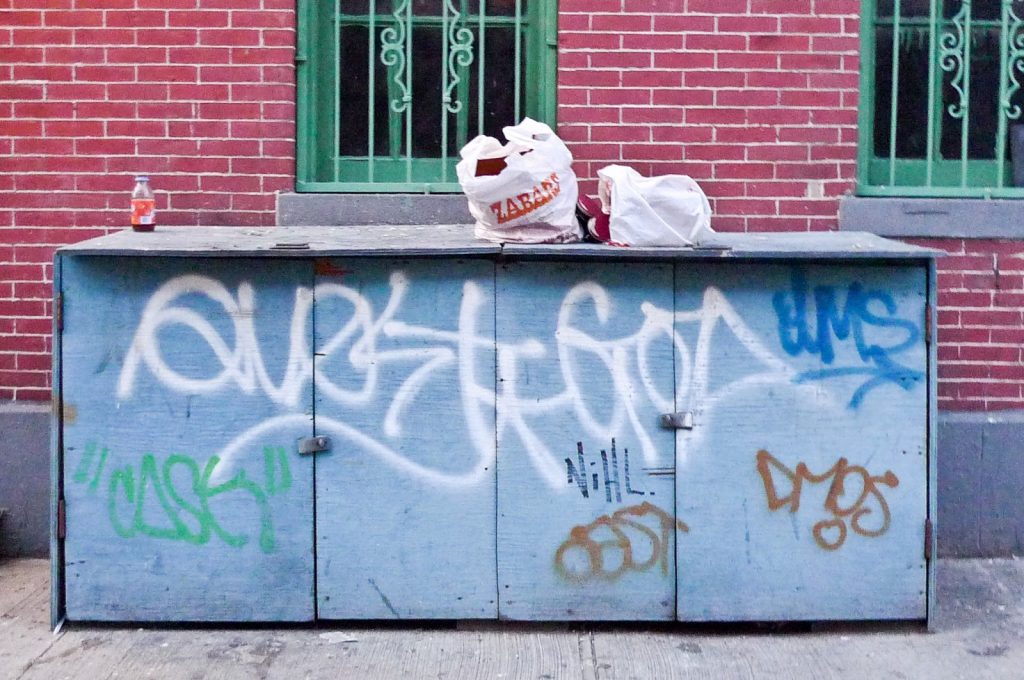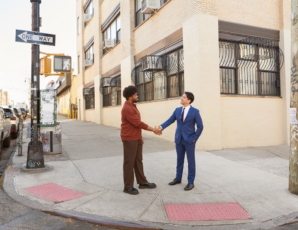
How do you get rid of your trash? (Source: Charley Lhasa via Flickr Creative Commons)
It’s almost 10, you just got home and you’re starving. Your first move, naturally, is to order a feast from the fastest-delivering spot on Seamless. In 25 minutes, a bag of warm-to-the touch treasures arrives all packaged up in plastic and tinfoil accompanied by five sets of plastic utensils and enough individual packets of condiments to last a lifetime – good thing soy sauce doesn’t go bad, right? After sating yourself, you fall into a stupor and for the time being ignore the trail of detritus you’ve left in your wake – that is, the capsules of Sriracha, the partially used chopsticks, those Styrofoam vats of broth and the flimsy tins of summer rolls.
Not to sound like your mother, but what are you planning to do with all that garbage? Are you going to recycle it? Or are you going to stuff it all back in the bag it came in, tie up the handles and toss it out your front door to deal with on your way out to work in the morning? The unfortunate truth is many New York City apartment dwellers are pretty lazy when it comes to recycling and waste disposal. Hey, we lead hectic, hurried lives and depend on takeout, dry cleaning, Blue Apron and Amazon and all the packaging waste that results from them accumulates in our tiny spaces. Our apartments can barely fit one decent-sized garbage can let alone the three needed for a proper recycling station. On top of that, many landlords and property managers often do a lousy job of explaining building-wide recycling procedures and setting up communal recycling bins.
So the cards are stacked against us — yes we agree — but that’s not an excuse to not recycle. The city actually makes recycling pretty easy to adopt, especially for apartment dwellers. Read this guide on what you need to know to conquer the basics of recycling in your New York City apartment.
The Basics of Recycling in NYC
Things to know:
- Recycling is not an optional, brownie-points type of thing. It is required in all New York City apartments.
- Your landlord is required to provide an accessible central recycling area with signs that explain what and how to recycle and in general to inform you and your neighbors of the recycling rules and regulations.
- As a tenant, you must follow your landlord’s instructions accordingly and properly separate regular trash from recyclables and put them in their respective bins. In other words, it’s not your super’s job to sort your trash!
What Goes Where? (How to Sort Your Recycling)
In New York City, the Department of Sanitation have made things pretty simple for us and color-coded our recycling system. We have the blue bins and the green bins. If the garbage bins in your building are not color-coded themselves, they should have color-coded DSNY stickers adhered to them indicating whether they are blue or green.
Paper and Cardboard Go in the Green Bin
- Newspapers, magazines, catalogs
- White and colored paper
- Mail and envelopes
- Paper bags and wrapping paper
- Soft-cover books and telephone books
- Cardboard egg cartons and trays
- Smooth cardboard (such as food and shoes boxes, tubes, file folders, and cardboard from product packaging)
- Pizza boxes and paper cups
- Corrugated cardboard boxes
What Does Not Go in the Green Bins
- Paper with heavy wax or plastic coating (i.e., candy wrappers and those paper Chinese take-out containers)
- Soiled or soft, wet paper (used tissues, diapers, toilet paper etc)
- Hardcover books
Metal, Plastic and Glass Go in the Blue Bin
You should empty and rinse all containers before recycling them – that means beer cans, wine bottles, OJ cartons and, yes, take-out containers.
- Metal cans
- Aluminum foil wrap and trays
- Metal caps and lids
- Small metal items like wire hangers, pots, tools, curtain rods, knives and other small appliances that are mostly metal
- Bulk metal (yep, you can recycle large metal items like furniture and cabinets
- Glass bottles
- Glass jars
- Plastic bottles, jugs, and jars
- Rigid plastic food containers (i.e., yogurt, deli, or hummus containers; dairy tubs, cookie tray inserts, and other plastic take-out containers)
- Rigid plastic packaging
- Rigid plastic housewares (i.e., flower pots, mixing bowls, and plastic appliances)
- Bulk rigid plastic (i.e. crates, buckets, pails, furniture, large toys, and large appliances)
- Food and beverage cartons and juice boxes
What Does Not Go in the Blue Bins
- Batteries
- Plastic bags, foam, squeeze tubes (i.e., toothpaste, lotion)
- Electronics
- Light bulbs
- Sponges
- Disposable razors
Recycling Solutions for Your Small Apartment
Great. We’re now all clear on how and what we can recycle. Do you know how you’re going to put these recycling practices into action? It would be 100 times easier if we had kitchens big enough for separate recycling bins for each of the different types of trash, but that’s not happening in your tiny galley kitchen. Instead of trying to stuff an oversized contraption from the Container Store under your sink, here are some practical recycling solutions for your small apartment.
- Keep a paper grocery bag or cardboard box by the front door and toss in junk mail, magazines and newspapers that you no longer want as well as flattened boxes. When it’s full, bring it down to the green bin and drop the whole thing in.
- Use heavy-duty magnets to hold a sturdy trash bag to the side of the fridge to toss plastic, glass, cans into to avoid having to squeeze an additional trash can under the sink or in a corner. When it gets full, take the whole bag down to the blue bin and drop it there. You can also hang a plastic bag on the knob of your front door. Both options will encourage you to take out the trash more frequently to avoid build up and overflow, which is ultimately a good thing.
Related:










